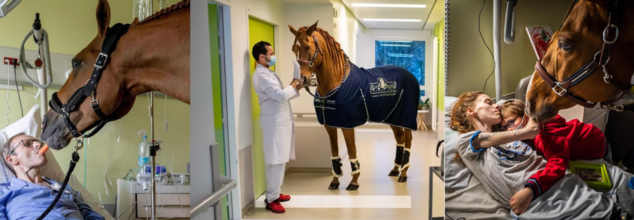- Health Conditions A-Z
- Health & Wellness
- Nutrition
- Fitness
- Health News
- Ayurveda
- Videos
- Medicine A-Z
- Parenting
- Web Stories
Meet 'Doctor Peyo' - The Therapy Horse Who Is Changing End-of-Life Care

Credits: Instagram and Facebook
In a quiet corner of northern France, in the halls of Calais Hospital, a most unlikely therapist walks with quiet dignity—on four hooves. Dr. Peyo, as he is affectionately known, is a 15-year-old stallion with a heart as remarkable as his story. Once a celebrated show horse, Peyo has now become a symbol of peace and comfort for terminally ill patients, offering them something few humans can: a wordless, instinctive presence in their final days.
His journey from show arena to hospital corridors began with a curiosity that his owner and trainer, Hassen Bouchakour, couldn’t ignore.
From Spotlight to Silent Comfort
Peyo once dazzled audiences in equestrian performances across France. But it was after each show that Bouchakour noticed something unusual. Instead of basking in applause or returning to the stables, the stallion would walk straight into the crowd, approaching individuals with disabilities or those who appeared unwell. He would stand quietly beside them, as if sensing their inner battles.
“I didn’t understand it at first,” Bouchakour admits, as reported in Guardian. “But it kept happening—every time.”
Intrigued, he sought help from veterinarians and neurological experts. After four years of observation and testing, the professionals agreed: Peyo’s brain function was unlike any other horse they had studied. Though the exact science remains a mystery, one thing was clear—Peyo had a rare ability to detect emotional and physical suffering with uncanny accuracy.
Doctor Peyo Begins His Rounds
In 2016, Bouchakour left his performance career behind to follow his horse’s calling. Together, they began visiting hospitals, particularly palliative care and cancer wards. The response was profound.
Unlike therapy animals trained to follow cues, Peyo operates entirely on instinct. At Calais Hospital, he freely roams the halls, choosing whom to visit. He signals Bouchakour by stopping at a room and lifting his front leg—his way of saying someone inside needs him.
In many cases, Peyo enters the rooms of the very sick—those near death. He gently rests beside their beds, allowing them to touch his thick mane or lean against his warm body. The reaction is often emotional: tears, smiles, or sudden, unexpected words from patients who hadn’t spoken in days.
A Ritual of Care
Cleanliness and safety are essential, and Peyo’s daily hospital routine is strict. Each day, Bouchakour spends nearly two hours grooming the stallion—brushing his coat, braiding his mane, cleaning his hooves, and applying antibacterial lotion before draping him in a clean hospital-grade blanket. He is then allowed to roam—at his own pace, by his own choosing.
Peyo's interactions have surprised medical professionals. Patients suffering from severe anxiety calm down in his presence. Some who had lost the will to move begin walking again. A few elderly women even visit the hairdresser the day before his visit—just to look their best for him.
A Gentle Goodbye
For more than 1,000 terminally ill patients, Peyo has been more than just a visitor—he’s been a companion on their journey out of life. His presence offers not just comfort, but a kind of validation: a reminder that they are not alone, not forgotten.
Bouchakour recalls the case of Daniel, a 67-year-old man dying of cancer and a former equestrian. “He was overcome with emotion,” he says. “It was as if Peyo knew him.” When Daniel passed away, his family asked that Peyo and Bouchakour walk beside his coffin at the funeral.
“In the past, people died at home,” Bouchakour reflects. “Now, many pass away in sterile hospital rooms, often alone. We’ve lost the softness of death, the dignity. Peyo brings some of that back.”
The Mystery Remains
Science still can’t fully explain Peyo’s sensitivity. His brain scans show rare neurological patterns, but no one knows why he can do what he does. Some call it intuition, others magic. But perhaps it doesn’t need a label.
“Patients who wouldn’t speak suddenly find words. Some who had nothing left to give smile again. He gives them a moment—sometimes the last moment—of peace,” says a nurse at Calais, as reported in Uplifting Today.
As he continues to visit those at the edge of life, Peyo remains quiet, patient, and ever-gentle—a silent companion for those taking their final breath. In a world that often fears death, Dr. Peyo offers something rare: the courage to face it with calm, dignity, and the soft muzzle of a friend by your side.
Got Covid And Feeling Worse? These 3 Symptoms Could Be A Major Warning

Credits: Canva
Health officials are urging people to seek immediate medical help if they notice three particular symptoms appearing alongside Covid, as these could signal a more serious infection.
According to the latest data from the UK Health Security Agency (UKHSA), Covid cases have dipped slightly but remain present at “low levels” across the country. Hospital admissions have also fallen modestly, with weekly test positivity dropping to 10.3 percent from 11.9 percent the week before.
Despite the decline, people aged 85 and older continue to face the greatest risk of being hospitalised with the virus. Experts stress that identifying certain warning symptoms early can be key to preventing complications and ensuring timely treatment.
3 Covid Symptoms That Are Major Warning
People are being urged to seek urgent medical advice if they or their child develop three specific symptoms while infected with Covid, as it may point to a more serious illness.
Health experts recommend contacting a GP or calling for medical assistance if symptoms such as a rash, loss of appetite, or unusual weakness appear. Immediate help is also advised if a high temperature of 38°C or above lasts for five days or fails to reduce with paracetamol.
Medical attention is further encouraged if symptoms worsen, show no improvement, or if you are unsure how to manage them. For infants, extra caution is necessary as any baby under three months old with a temperature of 38°C or higher, or a child aged three to six months with a temperature above 39°C, should be assessed by a healthcare professional.
Covid Booster Shots: Who Can Get Them This Autumn
The eligibility rules for Covid booster vaccines have been updated for the current autumn rollout. While earlier boosters were offered to people aged 65 and above and those with certain long-term conditions, this year’s criteria have been made more specific.
Those eligible for the latest booster include:
- Adults aged 75 and over, including anyone who will turn 75 by January 31, 2026
- Individuals aged six months to 74 years with a weakened immune system due to illness or medical treatment
- Residents of care homes for older adults
- Health officials continue to encourage eligible groups to stay up to date with vaccinations, especially heading into the winter season, when respiratory infections tend to rise.
COVID-19 Variant Stratus: What You Should Know
A new COVID-19 strain known as Stratus, officially labeled XFG, has begun to circulate globally. First identified in Southeast Asia in January 2025, the variant quickly spread across 38 countries by mid-year. The World Health Organization (WHO) has classified Stratus as a “variant under monitoring,” meaning it is being closely studied to understand its transmission rate, symptom pattern, and potential health impact.
Frankenstein Variant: Common Symptoms of Stratus
For most people, especially those who are vaccinated or boosted, Stratus infections appear to be mild to moderate. Still, recognising its symptoms early remains important.
The most common signs include:
- Persistent dry cough
- Tiredness or fatigue
- Fever
- Other possible symptoms:
- Shortness of breath or chest tightness
- Sore or scratchy throat
- Headache and body aches
- Upset stomach, nausea, or loss of appetite
- Loss of taste or smell (now less frequent)
- Brain fog or difficulty concentrating
Atorvastatin Recall 2025: Safe Alternatives For Keeping Cholesterol In Check

Credits: CANVA
Atorvastatin Recall 2025: Statins have long been the first-line treatment for high cholesterol, but the Food and Drug Administration (FDA) has confirmed a nationwide recall of over 140,000 bottles of a cholesterol-lowering medication. Officials flagged that some pills may not dissolve properly after ingestion, potentially reducing effectiveness for patients who rely on them daily.
The recall affects Atorvastatin Calcium, the generic version of Lipitor, which is taken by roughly 39 million Americans, most of them adults over 40, according to Dr. Tamanna Singh of the Cleveland Clinic. Federal records show that the recalled batches were manufactured by Alkem Laboratories and distributed by Ascend Laboratories in New Jersey. The FDA’s September 19 enforcement report found that several batches failed quality tests designed to ensure proper dissolution of the pills.
If the pills dissolve inconsistently or more slowly than intended, the medication may not deliver the expected cholesterol-lowering effect. The FDA classified the recall as a Class II action, indicating moderate concern. While temporary or reversible side effects could occur, the likelihood of serious harm is low.
Atorvastatin Recall: Which Atorvastatin Tablets Are Affected
The recall covers multiple strengths and bottle sizes of Atorvastatin Calcium Tablets, which are among the most commonly prescribed statins globally. Affected formulations include:
- 10 mg – 90, 500, and 1,000 tablets per bottle
- 20 mg – 90, 500, and 1,000 tablets per bottle
- 40 mg – 90, 500, and 1,000 tablets per bottle
- 80 mg – 90 and 500 tablets per bottle
Cholesterol Medication Recalled: Safe Alternatives to Atorvastatin
If you are affected by the recall, there are several alternatives to help manage cholesterol levels effectively:
1. Ezetimibe (Zetia)
Ezetimibe is often recommended when a statin alone doesn’t sufficiently lower cholesterol. It may be used if you are on the maximum statin dose but your cholesterol remains high, or alongside statins such as atorvastatin or simvastatin for conditions like homozygous familial hypercholesterolemia.
Ezetimibe works by blocking cholesterol absorption in the small intestine, causing the body to use up more cholesterol from the blood. It is one of the few non-statin medications that can further reduce LDL cholesterol, either alone or combined with statins or other alternatives.
2. Fibrates (e.g., gemfibrozil, fenofibrate)
Fibrates mainly target high triglyceride levels, a type of fat in the blood linked to heart disease and pancreatitis, and can also mildly lower LDL cholesterol. They can be taken alone, with ezetimibe, or with a statin. However, combining gemfibrozil with a statin may increase side effects, so caution is advised.
3. Bile Acid Sequestrants (e.g., cholestyramine, colestipol, colesevelam)
Bile acid sequestrants lower cholesterol by binding bile acids in the intestine, preventing their reabsorption. The liver then uses more cholesterol from the blood to produce new bile acids, reducing LDL cholesterol.
Potential drawbacks include:
- Multiple pills per day may be needed
- Possible interactions with other medications or vitamins, which can reduce effectiveness
- May increase triglyceride levels
- Can cause constipation or stomach upset
Can A Tick Bite Make You Allergic To Meat? The Surprising Science Behind Alpha-gal Syndrome

Credits: Canva
Imagine sitting down to a juicy, perfectly cooked steak on a warm evening, and hours later you’re hit with terrible stomach cramps, itchy hives, and swelling so bad you might need to rush to the ER. The weird part? It’s not food poisoning, and the steak wasn’t bad. What’s actually happening is your own immune system is reacting, because of a tiny tick bite you got weeks or even months ago, one you probably don’t even remember.
What Is Alpha Gal Syndrome?
Alpha-gal syndrome is a food allergy that can develop after a tick bite, leading to allergic reactions to red meat and products made from it. While several types of ticks can trigger it, the lone star tick is the most common culprit. Not everyone who gets bitten will develop the allergy, but repeated bites can increase the risk or worsen symptoms, as per Cleveland Clinic.
What Can Trigger an Alpha-gal Reaction?
You may have an allergic reaction to:
- Meat from mammals, such as beef, pork, or lamb
- Foods or products made with animal fat
- Certain medications
- Cow’s milk and dairy products
Alpha-gal is a sugar molecule found in most mammals (except humans) and in tick saliva. Not everyone who is bitten by a tick develops alpha-gal syndrome, and you might not react to every food or product that contains it.
Symptoms of Alpha-gal Syndrome
Alpha-gal syndrome can cause reactions ranging from mild to life-threatening. Common symptoms include:
- Skin changes, like itching, hives, or flushing
- Swelling of lips, eyelids, throat, tongue, or face (angioedema)
- Respiratory issues, such as cough, shortness of breath, or wheezing
- Digestive problems, including stomach pain, diarrhea, heartburn, nausea, or vomiting
- Dizziness or fainting
- Joint pain
Timing of Symptoms
Unlike most food allergies, reactions to alpha-gal can occur two to six hours after eating meat or dairy. Medications containing alpha-gal may trigger a faster reaction.
Causes of Alpha-gal Syndrome
Alpha-gal syndrome develops after a tick bite, most commonly from the lone star tick, though bites from black-legged (deer) ticks and other species can also cause it. Ticks carry alpha-gal molecules in their saliva, and exposure during a bite can make your immune system recognize alpha-gal as a threat, triggering an allergy.
Experts aren’t certain why some people develop the allergy while others do not. Repeated tick bites can worsen symptoms or make reactions more frequent.
What Is Lone Star Tick?
The lone star tick is a tiny bug, sometimes as small as a poppy seed. Adult female lone star ticks are easy to identify by the white dot on their backs, the “lone star.” They are commonly found in and around wooded areas across the Midwestern and Eastern United States.
Having alpha-gal syndrome is not just about giving up burgers or steaks. Like other food allergies, it can affect a range of products you may need to avoid. While caution is important, most people with AGS won’t react to every item that contains alpha-gal, and for some, symptoms may improve within a few years. Your healthcare provider can guide you on which foods to steer clear of and what to expect in your individual case.
© 2024 Bennett, Coleman & Company Limited

